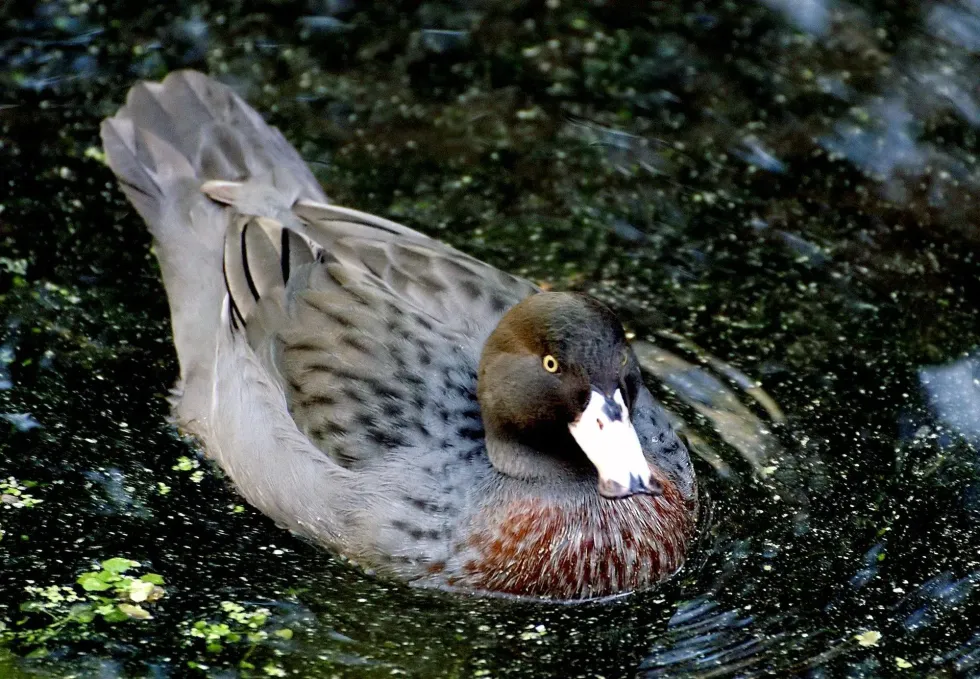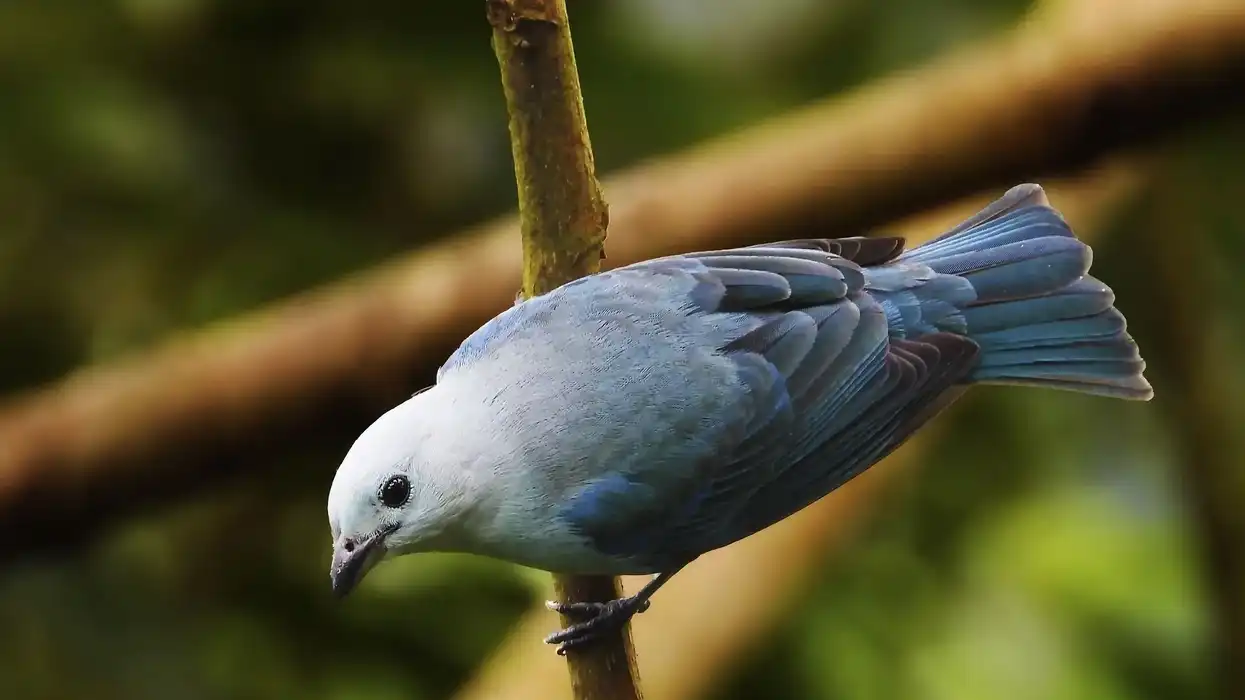Ducks are one of the most fun and friendly animals. Their population has been decreasing in the past decade due to predation by other animals and habitat loss.
The whio bird, also known as the blue duck, the mountain duck, and the blue mountain duck, is an endangered species. Their population is decreasing and will become worse in the next few years if the situation persists.
Though the major reason for the decline is predation by stoats, feral cats, domestic dogs, and other animals, nature has also boosted this in its own way. The whio lives in water bodies and adjacent areas.
They are fast swimmers and can even swim in fast flowing water bodies.
The most distinct feature about this bird is its bill that has a different color for the first 80 days. Did you know the whio duck picture is found on 10 dollar notes in New Zealand?
We have curated a bunch of interesting facts about the whio birds for you. Do not miss out on them, keep reading, and do check out our other related articles on crested duck and hooded merganser.
Blue Duck Interesting Facts
What type of animal is a blue duck?
The blue duck, also known as whio (fee-oh) is a type of duck that belongs to the Anseriformes family.
What class of animal does a blue duck belong to?
Hymenolaimus malacorhynchos (whio) is a member of the Aves class of the Animalia kingdom.
How many blue ducks are there in the world?
Currently, there are around 3000 whio individuals in the wild, of which the breeding population is between 1000 - 1200. Their population is currently threatened and decreasing due to predators.
Where does a blue duck live?
Whio lives in the north and south islands of New Zealand. It mainly occupies the rivers of Otago and Southland. It can also be spotted in the national parks of the central island (New Zealand).
What is a blue duck's habitat?
Whio birds mainly occupy fast flowing rivers, fast flowing mountain rivers, and streams. They prefer the alpine river regions and bush fringed rivers of New Zealand.
Whio birds make use of the scrubs and woods next to river regions to escape from predators like stoats. This is easy as the bird has a dusky blue gray plumage which gives perfect camouflage in river beds and streams. This bird prefers clear water river regions with no sediments.
Who do blue ducks live with?
Whio ducks are monogamous and are seen in breeding pairs. They nest alone during the breeding season and can be seen visiting the same rivers throughout the year or sometimes year after year. The whio ducks live together as a family for about 80 days with the young ones before they leave the nest.
How long does a blue duck live?
The lifespan of the blue duck species is between 8-10 years. Whio birds might survive a little longer in captivity.
How do they reproduce?
Whio ducks are oviparous and reproduce by laying eggs. Males look for nesting sites filled with abundant food, followed by nesting, which generally begins by the end of August in blue ducks residing on the North Island.
Breeding starts a litter later in September for the species in the South Island. The female builds its nest with thick foilage and vegetation and lays a clutch of creamy white eggs.
Each clutch has four to seven eggs. The eggs are incubated by the females for about a month. Between November and December, the chicks are continuously fed by both the adult male and female blue ducks.
Around January, the young ducks are grown and take off from the nesting site to build their own nest and start a family. The young blue ducks attain sexual maturity by the end of the first year.
What is their conservation status?
The IUCN (International Union for Conservation of Nature) has classified the whio species as threatened. Their population is currently decreasing and will worsen if the situation persists.
Blue Duck Fun facts
What does a blue duck look like?
One of the fascinating features of the whio species is its bill. The color of the bill is green when they are young. As they grow older, the bill attains a pale pinkish color. The body is dusky blue-gray and the plumage has a green sheen.
They have a streamlined head and spotted chest region. The feather tips have white and black margins. They have large webbed feet.
How cute are they?
Whio ducks are extremely adorable and attractive. The blue and gray plumage and bill are their most attractive features.
How do they communicate?
They communicate by using call sounds. Females made continuous low pitched knocking sounds while the males emitted high-pitched whistles. The name whio was given based on the call sounds of male blue ducks. These birds produce whimpering sounds when disturbed or threatened. The sound made by a duck is called a quack.
How big is a blue duck?
The whio is 20-21 in (53-54 cm) in length. Males are larger than females. The blue duck is two times bigger than the pygmy goose.
How fast can a blue duck swim?
The whio ducks have large webbed feet. This helps them swim faster and cover long distances. These birds are even capable of swimming in fast flowing rivers. The exact speed at which they travel is not known.
They can even dive and dab. The whio ducklings are capable of swimming and diving right after they hatch. Half of the time the head and neck of a whio is immersed in water. They are not very good, or fast, flyers and are hesitant when it comes to flying.
How much does a blue duck weigh?
A female whio weighs between 24-31 oz (680-870 g) and a male whio weighs around 18.9-38 oz (820-1077 g).
What are the male and female names of the species?
There is no visible difference between the male and female species. The male whio is called a drake and the female whio is called a hen. Together as a group, they are called a brace.
What would you call a baby blue duck?
The baby blue duck can be referred to as whio duckling or juvenile.
What do they eat?
Whio ducks are insectivorous birds who search for food in water bodies. Unlike other birds or ducks, they get their food from the fast-flowing mountain rivers. A major part of their diet consists of caddis fly larvae.
They also consume other invertebrates, aquatic insects, and grubs. The population of this species has faced a significant decline due to predators and habitat loss. Predators like feral cats, domestic dogs, ferrets, rats, possums, and stoats were frequently introduced in New Zealand, which threatened their populations.
Are they dangerous?
Whio ducks are not dangerous. However, they will defend their territory fiercely. They are shy and not very sociable. They are most likely to hide when they spot a human. They are generally calm and only react when disturbed. Whio birds in the wild can be more aggressive when threatened.
Would they make a good pet?
Due to their population status, it is illegal to own a whio. They have not been kept as pets so far, so we do not know their temperament around humans. Whio ducks are very few in number, and owing them might affect their populations.
Did you know...
The tip of a whio's bill has a soft membrane, making it one of the very few birds with a soft bill.
Wild whio birds start mating sooner than other species so that they can mate again in the same year.
Whio duck pairs are very territorial and defend their small territories, next to water sources fiercely.
Ducks are one of the most intelligent animals that are capable of responding to commands at an early age.
The whio has waterproof wings due to the waxy nature of the feathers.
What color eggs do blue ducks lay?
Whio birds lay around four to seven eggs that are creamy white in color. The eggs are sometimes taken and nurtured in captivity as a part of the conservation process and to keep them safe from predators in the wild. After hatching, they are introduced into the nearby river regions or other water sources.
Where are blue ducks native to?
A few decades ago, a lot of whio pairs were seen in almost all parts of New Zealand. But in recent times, due to habitat loss and predation, the pairs are only seen in specific parts of the north and south islands of New Zealand. The whio duck is endemic to these regions of New Zealand.
Here at Kidadl, we have carefully created lots of interesting family-friendly animal facts for everyone to discover! For more relatable content, check out these long tailed duck facts and radjah shelduck facts pages.
You can even occupy yourself at home by drawing one on our free blue duck coloring pages.
Second image is by Tyrone Smith, Department of Conservation.








